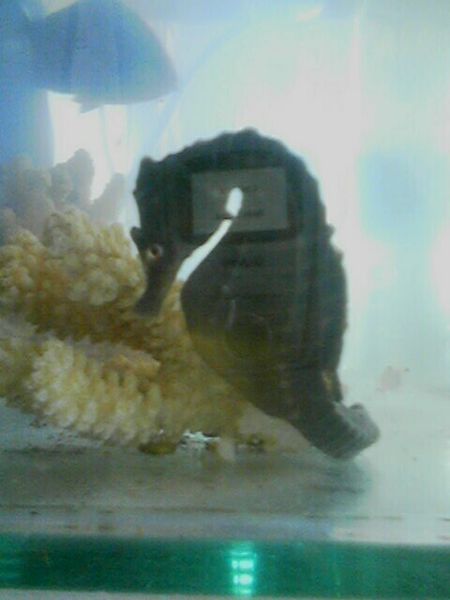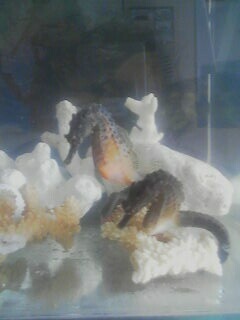 Hello, Frank Indiviglio here. Seahorse identification is a tricky prospect, as most species can change color, and many even periodically grow and discard fleshy appendages known as cirri. However, the husbandry needs of each species varies, so a proper ID is critical. Fortunately, the Big-Bellied or Pot-Bellied Seahorse (Hippocampus abdominalis) is very distinct in appearance.
Hello, Frank Indiviglio here. Seahorse identification is a tricky prospect, as most species can change color, and many even periodically grow and discard fleshy appendages known as cirri. However, the husbandry needs of each species varies, so a proper ID is critical. Fortunately, the Big-Bellied or Pot-Bellied Seahorse (Hippocampus abdominalis) is very distinct in appearance.
Description
At 12.5 inches in length, the Big-Bellied Seahorse is one of the largest (perhaps the largest) of the world’s 120+ seahorse species. The body is noticeably deeper than that of other seahorses. Males possess a huge brood pouch, which is usually white in color and bordered with yellow at the top. Other distinguishing features are the number of dorsal fin rays (26-29), trunk rings (12-13) and tail rings (45-48), all of which exceed those of most other species.
The spines are rounded, and those above the eye are quite prominent. The coronet (top of the head) is low and triangular in shape. The body is often bright yellow in color, but may be white or brown. Dark patches on the body, and alternating dark and light tail markings, are typical.
Males have longer tails and shorter snouts than do females, and usually bear a greater number of dark patches. They are heavier in weight as well, but females have a deeper keel.
Range and Habitat
Unlike many of its relatives, the Big-Bellied Seahorse inhabits decidedly cool waters. It is found along much of New Zealand’s coastline and off southeastern Australia, in waters that average 62 F in temperature.
It occupies both shallow and deep water, and is sometimes found attached to floating marine algae (seaweed) far from shore. Most individuals inhabit sheltered bays and harbors, where they attach via the prehensile tail to rocks, sponges and sea grass. Artificial structures such as docks and shark nets appear to be important habitat in some areas.
The breeding season extends from October to January, with males incubating the young in typical seahorse fashion for approximately 30 days. As many as 1,100 fry have been recorded in a single clutch.
Conservation
The Big-Bellied Seahorse is protected by law in Australia but not in New Zealand. All seahorses are listed on Appendix II of CITES; however, Norway, Japan, South Korea and Indonesia exempt seahorses from coverage.
Collection for use in Asian traditional medicine represents a serious threat to this species’ future, as does habitat loss. Many seahorses are killed as commercial trawler by-catch, and collection for the pet trade continues. Hobbyists should refrain from purchasing any seahorse that is not captive bred.
Captive Care

- Image via Wikipedia
The chief impediment to keeping this seahorse is its temperature requirements (see above) – a chiller is usually necessary; situating the aquarium in a cool basement may suffice.
Big-Bellied Seahorses are stronger swimmers, and travel further each day, than do other species, and should be provided with the largest aquarium possible.
Their large size simplifies feeding…newborn mollies and guppies, small shrimps, Mysids, scuds and similar creatures are all accepted. A diet comprised solely of brine shrimp will ensure their early demise…please see my article on The Atlantic Seahorse for detailed information on feeding and husbandry.
Big-Bellied Seahorses are crepuscular (active at dawn and dusk) – a night-viewing bulb may assist you in observing their behavior.
Further Reading
Please see my book, Seahorses, a Complete Care Guide, for more on this and other seahorses.
Big-Bellied Seahorse Video.
Please write in with your questions and comments.
Thanks, until next time,
Frank Indiviglio
Big Bellied Seahorse images referenced from wikipedia and originally posted by Josh Whitley
 That Fish Blog – Aquarium Advice and Information
That Fish Blog – Aquarium Advice and Information


Due to the large size of the animal will they take frozen krill as a food source in captivity?
Hi Tom, Full-grown adults may be able to take smaller thawed krill but larger krill would probably be too large to fit through the snout. They should be given food appropriate to their size as they grow; smaller and younger seahorses would of course need much smaller food than the adults.